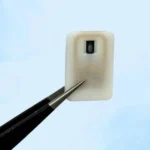Researchers at Heidelberg University and the Max Planck Institute for Medical Research have developed a method for designing and synthesizing crosslinkable oligomers with controlled monomer sequences. This approach allows for the creation of sequence-defined macromolecules, which can be used as inks in additive 3D microprinting.

The study, published in the journal “Small,” demonstrates how varying the sequence of monomers can systematically change the properties of the printed material. Researchers created three different oligomers, each with a unique sequence of photocross-linkable and non-functional units. These oligomers were then used to 3D print intricate structures, such as “buckyball” models, with varying mechanical properties and resolution.
One of the key findings of the research is that the sequence of monomers plays a crucial role in the printing process. For example, an oligomer with alternating crosslinkable and non-functional groups exhibited the best print quality, requiring the lowest light intensity for printing while maintaining high mechanical integrity. This result suggests that the distribution of crosslinkable groups within the polymer chain can significantly impact the final product’s quality.
This advancement in macromolecular engineering offers a new way to tailor 3D printed materials. By controlling the sequence of monomers, it becomes possible to program specific properties into the material, such as mechanical strength, flexibility, and the ability to form complex structures.

The implications of this research are vast, potentially leading to the development of new materials for applications ranging from targeted drug delivery to the creation of micro-scale devices such as micro-optics and microrobotics. It represents a step towards replicating the intricacy and functionality of biological materials in synthetic 3D printed structures.
You can read the full research paper, titled “Macromolecular Engineering: From Precise Macromolecular Inks to 3D Printed Microstructures” at this link.
Come and let us know your thoughts on our Facebook, X, and LinkedIn pages, and don’t forget to sign up for our weekly additive manufacturing newsletter to get all the latest stories delivered right to your inbox.










